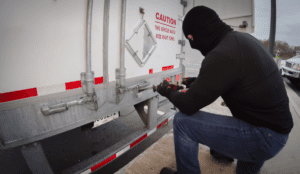 In the United States, there are a lot of billion dollar industries, led by hospitals, pharmaceuticals, commercial banking, life insurance, and petroleum wholesaling to name a few. However, there is probably one industry that most of us would not think of in this list: the cargo theft industry. According to the National Insurance Crime Bureau (NCIB), cargo theft in the United States is a $15 to $35 billion industry. Depending on what’s inside the truck, thieves can walk away with thousands to millions of dollars.
In the United States, there are a lot of billion dollar industries, led by hospitals, pharmaceuticals, commercial banking, life insurance, and petroleum wholesaling to name a few. However, there is probably one industry that most of us would not think of in this list: the cargo theft industry. According to the National Insurance Crime Bureau (NCIB), cargo theft in the United States is a $15 to $35 billion industry. Depending on what’s inside the truck, thieves can walk away with thousands to millions of dollars.
Cargo theft is “the criminal taking of any cargo including, but not limited to, goods, chattels, money, or baggage that constitutes, in whole or in part, a commercial shipment of freight moving in commerce, from any pipeline system, railroad car, motortruck, or other vehicle, or from any tank or storage facility, station house, platform, or depot, or from any vessel or wharf, or from any aircraft, air terminal, airport, aircraft terminal or air navigation facility, or from any intermodal container, intermodal chassis, trailer, container freight station, warehouse, freight distribution facility, or freight consolidation facility.”
Cargo Theft Tactics
Cargo theft comes in many shapes and sizes. According to Travelers Insurance, there are five main cargo theft tactics to watch out for. The first is straight cargo theft, where cargo is physically stolen from a location. Second is strategic cargo theft, which uses deceptive means to commit theft, including the use of fraud and deceptive information to trick brokers into giving up a load. Third is the use of technology, such as GPS blockers to hide the location of a stolen container or truck. Fourth is the use of cyber-attacks, such as phishing scams and malware used to access sensitive data. And fifth is pilferage, which is the theft of small quantities of items that are often overlooked until a trailer or container is unloaded.
Over the last few years, there has been more emphasis on the second tactic: strategic cargo theft. There were 582 supply chain events reported across the United States and Canada in the second quarter of 2023, a 57 percent increase when compared to the second quarter of 2022, according to the latest CargoNet report. In fact, much of the increase is due to ongoing shipment misdirection attacks, a kind of strategic cargo theft in which actors use stolen motor carrier and logistics broker identities to obtain freight and misdirect it from the intended receiver so they could steal it. The strategic theft category is actually up 600 percent from November to March.
Scott Cornell, transportation lead and crime and theft specialist at Travelers, outlined how strategic theft works. In an interview with Fleet Owner, Cornell said “the industry increasingly sees a combination of identity theft and double brokering. Criminals operating a fictitious carrier might pick up a load from a broker before turning around and double brokering that load to a legitimate carrier. The thieves might instruct that carrier to take the load to a cross-dock where it could be picked up and taken to its final destination. Sometimes thieves will hire a second legitimate trucking company to take the load to a public use warehouse to watch the load, surveilling the cargo to see if it is being tracked before moving the freight to its final destination.”
The trucking industry as a whole is doing what it can to combat cargo theft. Most of this is done by educating shippers and carriers on the risk of cargo theft, and what to do if and when it happens. However, as technology continues to improve, and cargo thieves become smarter and bolder, there is only so much that can be done. To limit the impact of cargo theft, the NICB recommends a layered approach:
- Screen all employees, including drivers, warehouse employees, and those with access to shipping information.
- Train employees making certain to educate truck drivers in hijack awareness and prevention. Training safeguards the employee, trailer, tractor, cargo, and customers.
- Be smart in selecting transportation partners, making certain they share your security philosophy.
- Implement in-transit security measures. Cargo theft can be pre-planned or opportunistic.
- Keep a vigilant eye. Include countersurveillance in the duties of your security guards. Trucks and cargo are most vulnerable to theft when sitting idle.
- Take advantage of technology, installing alarm surveillance systems and responding to all alerts. Ensure the perimeter, entrances, building doors, and windows are well lit. Vehicle and cargo tracking, immobilizers, and advanced security seals are available.
- Conduct audits of the supply chain and look for gaps in shipment protection.
While these recommendations will not eradicate cargo theft, they can certainly help shippers and carriers be better prepared. As we head into the holiday season, organized cargo theft will likely be on the rise, especially strategic cargo theft. Preparation will be key to reducing the amount of goods that are stolen or misdirected, and hopefully move things in the right direction, away from a billion dollar industry.
















